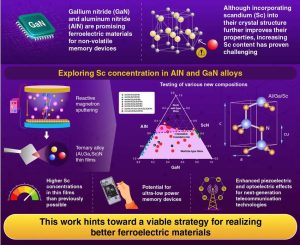R&D: Innovative Ternary Alloy Films Pave Way for Ultra-low-power Memory Devices
Study reports (Al,Ga,Sc)N thin films with record-high scandium levels, with exciting potential for ultra-low-power memory devices.
This is a Press Release edited by StorageNewsletter.com on July 3, 2025 at 2:00 pmFrom Institute of Science Tokyo
A recent study reports (Al,Ga,Sc)N thin films with record-high scandium levels, with exciting potential for ultra-low-power memory devices, as reported by researchers from Institute of Science Tokyo (Science Tokyo).
Impact of film composition on crystal structure and ferroelectricity in (Al1−x−yGaxScy)N ternary wurtzite thin films
Ota et al. (2025) | APL Materials | 10.1063/5.0261572
Click to enlarge
Using reactive magnetron sputtering, they fine-tuned the composition of ternary alloys to overcome previous stability limits. Beyond enabling efficient data storage, these films also show promise for noise filters for 6G communications and optical computing, thanks to attractive piezoelectric and optoelectric properties.
World’s First Higher Scandium Content-Based Alloy for Next-Gen Memory Technology
Electronic devices are becoming smaller yet more capable than ever, creating a demand for memory technologies that can store more data while consuming less power. Non-volatile ferroelectric memories have emerged as a promising solution to this issue. By maintaining an intrinsic electrical polarization, these devices can retain stored information without requiring constant electrical power — thus extending battery life and enabling more sophisticated mobile computing.
Gallium nitride (GaN) and aluminum nitride (AlN), materials already used in LEDs, possess unique crystal structures where positive and negative charge centers are naturally displaced. This displacement creates a switchable polarization that can be controlled by an applied external voltage, forming the foundation for non-volatile memory functionalities. Scientists know that incorporating scandium (Sc) into these crystal structures could significantly reduce operating voltages and enable ultra-low power operation. However, increasing the concentration of Sc has proven extremely challenging due to fundamental limitations in stability for both GaN and AlN.
Against this backdrop, a research team led by Professor Hiroshi Funakubo, Institute of Science Tokyo (Science Tokyo), Japan, has achieved a significant breakthrough by successfully synthesizing (Al,Ga,Sc)N thin films with unprecedentedly high Sc concentrations. Their groundbreaking work, published online in Volume 13, Issue 4 of APL Materials on April 22, 2025, demonstrates that alloying AlN with GaN in the right proportion can significantly expand the amount of Sc that can be incorporated into the final crystal structure.
First, the researchers employed reactive magnetron sputtering, a physical vapor deposition technique, to deposit thin films of (Al,Ga,Sc)N with carefully controlled compositions onto platinum- and titanium-coated silicon substrates. Through meticulous adjustment of the sputtering parameters and target power, they synthesized a diverse range of ternary alloys with different proportions of each element. These films were then rigorously characterized using advanced techniques such as X-ray diffraction to determine their crystal structure, electron microscopy to examine their microstructure, and electrical measurements to evaluate their ferroelectric and dielectric properties. Their systematic approach enabled them to map out the so-called ‘phase diagram’ of the AlN–GaN–ScN system, revealing a new region for the ferroelectrically active wurtzite crystal structure at higher Sc contents when a small fraction of gallium was present.
An important outcome of this research was the significant reduction in the material’s coercive field (Ec) — the electric field needed to switch polarization — that came with increasing Sc content in the ternary alloys. The team observed a remarkable decrease in Ec from 5.8 MV/cm to 1.8 MV/cm as the Sc ratio grew larger. “This Ec value is much lower than most reported values in previous works for various dopants of AlN- and GaN-based wurtzite films, which is very promising for the development of memory devices,” remarks Funakubo.
Further analysis of the results revealed that an entropy effect could be responsible for this effect.
Notably, the achieved voltage reduction could translate directly to lower power consumption in memory devices, addressing one of the most pressing challenges in modern electronics. Beyond memory applications, these novel ferroelectric films also exhibited superior piezoelectric and optoelectric properties.
“These properties open up potential applications in high-frequency noise filters and ultra-low-power optical computing systems, which are necessary for next-generation 6G smartphones and in optical computing devices that operate with ultra-low power,” says Funakubo.
Overall, the combination of reduced operating voltages, enhanced functional properties, and compatibility with existing semiconductor processing techniques makes (Al,Ga,Sc)N films promising materials for next-gen electronics.
Article: Impact of film composition on crystal structure and ferroelectricity in (Al1−x−yGaxScy)N ternary wurtzite thin films Open Access
APL Materials has published an article written by Reika Ota, Department of Materials Science and Engineering, Tokyo Institute of Technology, Yokohama 226-8502, Japan, Nana Sun, Kazuki Okamoto, Department of Materials Science and Engineering, Institute of Science Tokyo, Yokohama 226-8502, Japan, Shinnosuke Yasuoka, Department of Materials Science and Engineering, Tokyo Institute of Technology, Yokohama 226-8502, Japan, Yoshihiro Ueoka, Daiki Shono, Masami Mesuda, Tosoh Corporation, Ayase, Kanagawa 252-1123, Japan, and Hiroshi Funakubo, Department of Materials Science and Engineering, Tokyo Institute of Technology, Yokohama 226-8502, Japan, and MDX Research Center for Element Strategy, International Research Frontiers Initiative, Institute of Science Tokyo, Yokohama 226-8501, Japan.
Abstract: “The wurtzite-structure ternary alloys of (Al,Ga,Sc)N films with a high Sc/(Al+Ga+Sc) ratio are successfully deposited by a reactive magnetron sputtering method. The breakthrough in ScN solid-solution limit in AlN with wurtzite structure [up to Sc/(Al + Ga + Sc) = 0.47] is achieved, and its wurtzite-phase diagram region is expanded by adding a relatively small amount of Ga [Ga/(Al+Ga+Sc) < 0.1] into the (Al,Sc)N film. The c– and a-axes lattice constants depend strongly on Ga/(Al+Ga+Sc) and Sc/(Al+Ga+Sc) ratios, respectively, and the Sc/(Al+Ga+Sc) ratio primarily determines the internal structure showing a crystal anisotropy parameter, u parameter. The dielectric constant increases with the increase of Sc/(Al+Ga+Sc) ratio. In addition, the coercive field significantly decreases from 5.8 to 1.8 MV/cm with an increasing Sc/(Al+Ga+Sc) ratio from 0.33 to 0.47, while polarization slightly reduces with the increased u parameter. This result provides a new way to expand the content of the ScN solid solution in the wurtzite film to further decrease the coercive field for the memory device applications.“















 Subscribe to our free daily newsletter
Subscribe to our free daily newsletter


